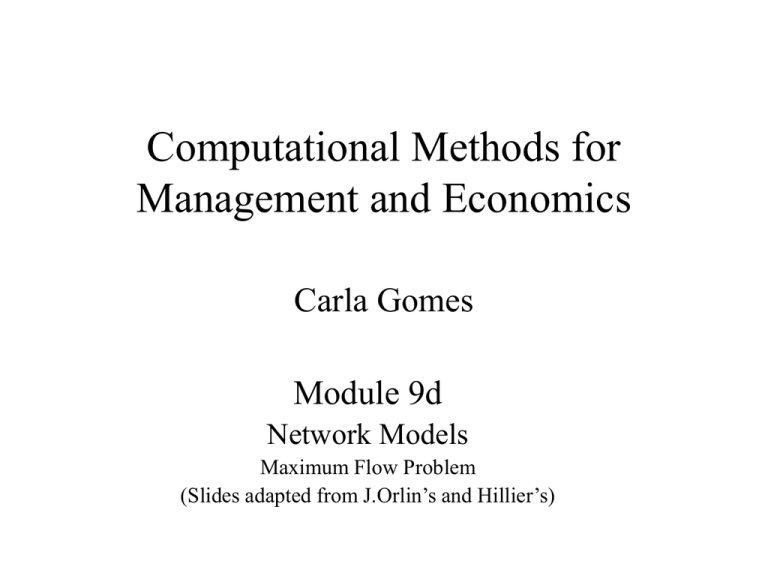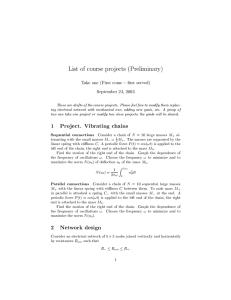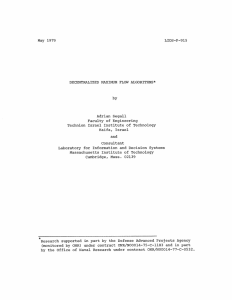Module 9d (ppt file)
advertisement

Computational Methods for Management and Economics Carla Gomes Module 9d Network Models Maximum Flow Problem (Slides adapted from J.Orlin’s and Hillier’s) The Maximum Flow Problem Maximum Flow Problem An oil company has the following pipeline network, where each pipeline is labeled with its maximum flow rate (in thousands of gallons per hour). 8 D B 7 3 10 A 6 1 F 4 10 2 C 12 G 2 8 E Question: What is the maximum possible flow rate from A to G? Spreadsheet Model 3 4 5 6 7 8 9 10 11 12 13 14 15 16 17 18 B C D From A A B B B C C C D D E E F To B C C D F B E F F G F G G Ship 7 10 0 7 0 0 8 2 0 7 0 8 2 Maximum Flow 17 E F <= <= <= <= <= <= <= <= <= <= <= <= <= Capacity 10 10 1 8 6 1 12 4 3 7 2 8 2 G H I Nodes A B C D E F G Net Flow 17 0 0 0 0 0 -17 J K Supply/Demand = = = = = 0 0 0 0 0 Assumptions of Maximum Flow Problems 1. All flow through the network originates at one node, called the source, and terminates at one other node, called the sink. (The source and sink in the BMZ problem are the factory and the distribution center, respectively.) 2. All the remaining nodes are transshipment nodes. 3. Flow through an arc is only allowed in the direction indicated by the arrowhead, where the maximum amount of flow is given by the capacity of that arc. At the source, all arcs point away from the node. At the sink, all arcs point into the node. 4. The objective is to maximize the total amount of flow from the source to the sink. This amount is measured in either of two equivalent ways, namely, either the amount leaving the source or the amount entering the sink. Some Applications of Maximum Flow Problems 1. Maximize the flow through a distribution network. 2. Maximize the flow through a company’s supply network from its vendors to its processing facilities. 3. Maximize the flow of oil through a system of pipelines. 4. Maximize the flow of water through a system of aqueducts. 5. Maximize the flow of vehicles through a transportation network. Maximum Flow Problem 8 D B [+L] 7 3 10 A (Upperbound On Max Flow) All other nodes 10 except G, are Trans-shipment nodes +M All other arc costs =0 6 1 F 4 2 C 12 G [-L] 2 8 E Question: How can it be transformed into a Min. Cost Flow Problem? Minimum Spanning Trees Minimum Spanning Trees: The Modern Corp. Problem • Modern Corporation has decided to have a state-of-the-art fiberoptic network installed to provide high-speed communication (data, voice, and video) between its major centers. • Any pair of centers do not need to have a cable directly connecting them in order to take advantage of the technology. All that is necessary is to have a series of cables that connect the centers. Question: Which cables should be installed to provide highspeed communications between every pair of centers. Modern Corporation’s Major Centers B 2 7 2 G 5 5 A 4 C E 7 4 1 D 3 4 1 F The Optimal Solution B 2 2 5 C A 1 D E 3 1 F G Assumptions of a Minimum-Spanning Tree Problem 1. You are given the nodes of a network but not the links. Instead, you are given the potential links and the positive cost (or a similar measure) for each if it is inserted into the network. 2. You wish to design the network by inserting enough links to satisfy the requirement that there be a path between every pair of nodes. 3. The objective is to satisfy this requirement in a way that minimizes the total cost of doing so. Algorithm for a Minimum-Spanning-Tree Problem 1. Choice of the first link: Select the cheapest potential link. 2. Choice of the next link: Select the cheapest potential link between a node that already is touched by a link and a node that does not yet have such a link. 3. Repeat step 2 over and over until every node is touched by a link (perhaps more than one). At that point, an optimal solution (a minimum spanning tree) has been obtained. (Ties for the cheapest potential link at each step may be broken arbitrarily.) Application of Algorithm to Modern Corp.: First Link B 2 7 2 G 5 5 A 4 C E 7 4 1 D 3 4 1 F Application of Algorithm to Modern Corp.: Second Link B 2 7 2 G 5 5 A 4 C E 7 4 1 D 3 4 1 F Application of Algorithm to Modern Corp.: Third Link B 2 7 2 G 5 5 A 4 C E 7 4 1 D 3 4 1 F Application of Algorithm to Modern Corp.: Fourth Link B 2 7 2 G 5 5 A 4 C E 7 4 3 1 D 4 1 F Application of Algorithm to Modern Corp.: Fifth Link B 2 7 2 G 5 5 A 4 C E 7 4 3 1 D 4 1 F Application of Algorithm to Modern Corp.: Final Link B 2 7 2 G 5 5 A 4 C E 7 4 3 1 D 4 1 F Applications of Minimum-SpanningTree Problems 1. Design of telecommunication networks (computer networks, leaseline telephone networks, cable television networks, etc.) 2. Design of a lightly-used transportation network to minimize the total cost of providing the links (rail lines, roads, etc.) 3. Design of a network of high-voltage electrical power transmission lines. 4. Design of a network of wiring on electrical equipment (e.g., a digital computer system) to minimize the total length of the wire. 5. Design of a network of pipelines to connect a number of locations.








